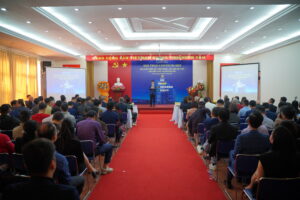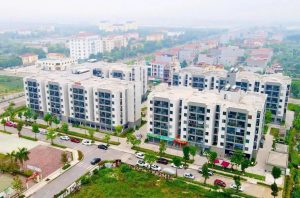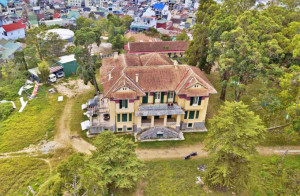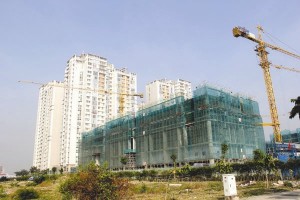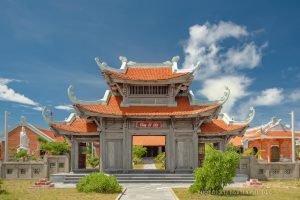Công bố quốc tế trong lĩnh vực kiến trúc, xây dựng (Tuần 1 tháng 11-2021)
Trong số này chúng tôi xin giới thiệu tới quý độc giả những nội dung chính của các công bố quốc tế đăng tải trên ScienceDirect và Springer Nature do Cục Thông tin khoa học và công nghệ quốc gia (NASATI) mua quyền truy cập như sau:
Quy hoạch đô thị:
– Hình ảnh chế độ xem phố trong phân tích đô thị và GIS
– Tích hợp các mục tiêu bảo tồn và các dịch vụ hệ sinh thái trong quy hoạch không gian cảnh quan của Bồ Đào Nha
– Hình dung cảnh quan trong tương lai: Mô hình trực quan hóa dựa trên dữ liệu cho các hệ sinh thái theo các kịch bản quản lý thay thế
– Tăng cường quy hoạch cảnh quan: Các dịch vụ hệ sinh thái qua trung gian thực vật được dự đoán bởi các đặc điểm thực vật
– Kiểm tra công bằng sinh thái trong hệ thống công nghệ-xã hội-sinh thái của thành phố New York, Hoa Kỳ
– Một cái nhìn sâu hơn về địa chính Thổ Nhĩ Kỳ
– Quy mô có quan trọng không? Tổng quan về tài liệu “thành phố thông minh”
– Đánh giá đặc điểm không gian của các đảo nhiệt đô thị từ góc độ mở rộng đô thị và cơ sở hạ tầng xanh
– Tối ưu hóa sử dụng đất đô thị đa mục tiêu bằng cách sử dụng dữ liệu không gian: Một đánh giá có hệ thống
– Đánh giá tác động của các kịch bản thiết kế đô thị đối với khả năng tiếp cận đi bộ: trường hợp của quận Madrid ‘Centro’.
Khoa học và công nghệ trong lĩnh vực kiến trúc, xây dựng:
– Một nghiên cứu phân tích, số và thực nghiệm về tán xạ sóng Rayleigh để đánh giá vết nứt dọc bên trong
– Các hành vi cơ học và đứt gãy của các chất thải mỏ vàng đã được nén chặt bằng các thử nghiệm uốn cong bán nguyệt và tương quan hình ảnh kỹ thuật số
– Phân tích số lượng và thực nghiệm đối với hỗn hợp hạt cao su-cát được áp dụng trong các đường hầm có nắp đậy cao
– Trụ xây được gia cố bằng các sọc thép mỏng: Chương trình thử nghiệm trên các mẫu vật quy mô nhỏ
– Dự đoán các thông số Marshall của mặt đường dẻo sử dụng máy vector hỗ trợ và lập trình di truyền
– Đánh giá tính năng lưu biến ở nhiệt độ cao của nhựa đường biến tính axit polyphosphoric-SBS và axit polyphosphoric-cao su vụn
– Một phương pháp đánh giá mới về độ đồng nhất của cấp phối cốt liệu cho mặt đường nhựa dựa trên các đặc điểm của kết cấu
– Khảo sát tính năng chống trượt của hỗn hợp bê tông nhựa gồm bô xít nung và cốt liệu đá vôi
– Đánh giá tiếng ồn mặt đường dựa trên đặc điểm kết cấu mặt đường ba chiều
Vật liệu xây dựng:
– Bê tông geopolymer làm vật liệu bền vững
– Hành vi của các giao diện RC chịu cắt
– Ảnh hưởng của vật liệu nano đến tính bền vững của bê tông xi măng: Đánh giá toàn diện
– Miếng dán lạnh trên nhựa đường để sửa chữa các ổ gà
– Đánh giá vai trò của graphene và các dẫn xuất của nó trong việc điều chỉnh các giai đoạn khác nhau của vật liệu tổng hợp geopolymer
– Ứng dụng kết tủa vi sinh vật trong bê tông tự phục hồi: Đánh giá về các chiến lược bảo vệ vi khuẩn
– Hiệu ứng làm chậm và bắc cầu của polyacrylamit anion trong hồ xi măng và mối quan hệ của nó với các đặc tính ban đầu
– Trên sự tách lớp của thủy tinh nhiều lớp polyvinyl butyral: Xác định các đặc tính đứt gãy từ mô hình số
– Các đặc tính cơ lý và khả năng chịu nước của tre moso biến tính nhiệt (Phyllostachys pubescens) như một hàm của mật độ
Xin trân trọng giới thiệu!
QUY HOẠCH ĐÔ THỊ
1. Street view imagery in urban analytics and GIS: A review
Landscape and Urban Planning, Volume 215, November 2021, 104217
Abstract
Street view imagery has rapidly ascended as an important data source for geospatial data collection and urban analytics, deriving insights and supporting informed decisions. Such surge has been mainly catalysed by the proliferation of large-scale imagery platforms, advances in computer vision and machine learning, and availability of computing resources. We screened more than 600 recent papers to provide a comprehensive systematic review of the state of the art of how street-level imagery is currently used in studies pertaining to the built environment. The main findings are that: (i) street view imagery is now clearly an entrenched component of urban analytics and GIScience; (ii) most of the research relies on data from Google Street View; and (iii) it is used across myriads of domains with numerous applications – ranging from analysing vegetation and transportation to health and socio-economic studies. A notable trend is crowdsourced street view imagery, facilitated by services such as Mapillary and KartaView, in some cases furthering geographical coverage and temporal granularity, at a permissive licence.
2.Integrating conservation targets and ecosystem services in landscape spatial planning from Portugal
Landscape and Urban Planning, Volume 215, November 2021, 104213
Abstract
Securing biodiversity values alongside ecosystem services and other socio-economic assets, is a priority in the European policy and territorial planning. Here, we design a landscape planning approach that identifies priority conservation areas and informs on their ecosystem services’ potential in the context of a legally binding spatial planning instrument in central Portugal. Our approach included a spatial prioritisation approach of biodiversity, a literature review on the potential supply of ecosystem services, the participation of political stakeholders, and expert-based field validation in the Municipality of Alvaiázere. Firstly, we used the decision-support software Marxan to help prioritising biodiversity conservation efforts. Then, we evaluated the potential supply of multiple ecosystem services from a systematic literature review. Finally, we selected priority areas for landscape planning and management through a participatory approach with local politicians, considering the relevance of those areas to safeguard biodiversity assets alongside ecosystem services’ potential supply for the region. A total of nine priority areas, with both high biodiversity values and potential for ecosystem services’ supply, were identified. For the first time in the country, those areas have been considered in the design of the main spatial planning instrument for the region, together with practical recommendations for in situ management. Our approach represents a first step to engage local administration in the EU Biodiversity Strategy for 2030, focused on the protection and restoration of biodiverse areas with ecosystem services’ potential through legally binding landscape planning.
3.Envisioning future landscapes: A data-based visualization model for ecosystems under alternative management scenarios
Landscape and Urban Planning, Volume 215, November 2021, 104214
Abstract
Human-driven landscape changes strongly influence landscape functionality and aesthetics. While landscape planners have access to biophysical data for decision-making, they often do not have the necessary information about social variables, such as aesthetic tastes, feelings, or functions of a place. Visualizing future landscapes under alternative management scenarios could be a valuable tool for aiding land management decisions. Towards these ends, empirical, quantitative ecological data on vegetation composition, pattern, and processes in a Long-Term Ecological Research (LTER) site in Israel were integrated into a computerized, 3-D representation of current and future landscapes.
Our objectives were (1) to visualize landscape-shaping processes, such as wildfire, grazing, and species colonization, that can assist managers, planners, and the public to envision the long-term visual significance of management alternatives and (2) to validate the similarity between the 3-D model and reality. The visual model we developed is based on 30 years of scientific knowledge and ecological data describing vegetation processes in Ramat Hanadiv, a case study of ecological conditions and processes relevant to the Mediterranean and other complex ecosystems worldwide.
Before studying the role of the 3-D model in decision-making, validation was performed by comparing ‘current state’ model representation with real-world photos from the perspective of the observer. The model was found to be a valid representation of reality.
Looking to the future, we suggest that the ability to create future landscapes using scientific data can assist to improve decision-making processes, balancing ecological and social needs.
- Enhancing landscape planning: Vegetation-mediated ecosystem services predicted by plant traits
Landscape and Urban Planning, Volume 215, November 2021, 104220
Abstract
Although well recognised in ecology, the concept of ecosystem services is still not widely applied in practical environmental planning. Environmental planning often has to evaluate whole landscapes in a spatially explicit way, including marginal landscape elements for which data on provisional, regulatory, and cultural ecosystem properties and services are not readily available or are costly to provide. On the other hand, many planning schemes include a habitat- or vegetation survey, raising the question whether ecosystem services can be predicted from vegetation properties alone. I used a large data set of herbaceous plant communities collected across Germany, The Netherlands, and Denmark, as well as additional data, to predict (i) the probability of obtaining a high marginal income from forage production, (ii) the probability of a high conservation value based on the occurrence of regionally rare plants, and (iii) carbon stocks in mineral soils (SOC). The predictions are based on 22 plant traits of 123 common species of reeds and of dry, mesic, wet, and ruderal grasslands. The individual traits were aggregated to trait modules representing major biological functions that affect the provision of services. High marginal income from forage production was predicted for plant communities functionally composed of intermediate levels of above-ground size and allocation, and an acquisitive leaf economy on the one hand, but little lateral expansion, generative reproduction and root mass on the other. The probability of finding regionally rare plants increased in communities with small-to-intermediate above-ground size, a conservative leaf economy, low C:N ratios, few and large seeds, and little lateral expansion. Communities displaying pronounced lateral expansion and above-ground size were linked to high soil organic-carbon stocks. The models predict trade-offs between these ES that are relevant to environmental planning. Where income from forage production is high, regionally rare plants will not be found, and SOC will be low. Where SOC is high, income from forage production will be low and rare plants infrequent. Where many rare plants are found, neither income from forage production nor SOC will be high. Using the predictive functions and the trait data provided in the Appendix S3, users can evaluate the supply of the three services for many perennial herbaceous communities in northwestern Europe.
- Is green space exposure beneficial in a developing country?
Landscape and Urban Planning, Volume 215, November 2021, 104226
Abstract
Previous studies have confirmed the beneficial effects of green space exposure on depressive disorders, but the majority of them were conducted in developed countries. Given the difference in utilization of green spaces in countries with agriculturally heavy economies such as Indonesia, the effects of green space remain unknown. This study aimed to investigate the association between green space exposure and depressive disorders, focusing on Indonesia. Depressive disorders data provided by the Institute for Health Metrics and Evaluation was used. Exposure to the green space was based on the normalized difference vegetation index (MODIS-NDVI) and green land-cover data provided by the Geospatial Information Agency of Indonesia. A generalized additive mixed model was conducted, followed by a sensitivity test and positive-negative control analysis, to evaluate the association. Stratified analysis was employed to assess the effects of green space on depressive disorders in areas with different levels of urbanization. Exposure to green space significantly reduced the risk of depressive disorders by up to 5% per interquartile unit increment of NDVI. Moreover, there was a 12.4% reduced risk of depressive disorders coinciding with an 8.4% increase in the proportion of forest and total vegetation. In high-urbanization areas, the results of sensitivity analysis illustrated that green spaces reduced the risk of depressive disorders by 10%. Exposure to green spaces was confirmed to be associated with a reduced risk of depressive disorders in Indonesia. Findings of this ecological study could serve as references for urban planning, considering the health benefits of green spaces in developing countries.
- Examining ecological justice within the social-ecological-technological system of New York City, USA
Landscape and Urban Planning, Volume 215, November 2021, 104228
Abstract
Examining justice in cities requires using analytical approaches that can unpack their complex nature and reveal the many interacting dimensions that affect justice patterns and processes. Although justice in cities has been examined extensively, it has primarily focused on social and environmental dimensions. However, justice is multi-dimensional, influenced and affected by multiple actors, dynamics, and processes. In this paper we propose the use of ecological justice, as justice of, to, and for nature as a critical lens for portraying a more integral understanding of urban injustices. This lens extends the notion of justice to nature through four dimensions: distribution of harmful impacts, recognition of nature, participation of nature, and the capabilities of social-ecological systems. Through a relational lens we develop a methodology that uses the social-ecological-technological system (SETS) conceptual framework to unpack how the dimensions and interactions affect ecological justice across urban landscapes. This methodology is operationalized into measurable variables and applied through a case study in New York City. A spatial analysis of indicators that act as SETS-Justice proxies at a Community District level, reveal high spatial variability of ecological justice hotspots when looking at each dimension independently. Identifying ecological justice hotspots can provide critical information for improving ecological justice through multiple means. For example, hotspots lacking in social-ecological recognition and participation of nature can inform context-specific solutions such as policies and projects that target community engagement, capacity building, and improve ecological knowledge. Additionally, a composite analysis of SETS-Justice through the aggregation of all indicators, reveals justice hotspots different to those commonly mapped in other justice-focused studies. This approach highlights the need to jointly address issues of environmental and ecological justice.
- A closer look at Turkish cadastre and its successful completion
Land Use Policy, Volume 110, November 2021, 104951
Abstract
Land underpins most social, economic and an environmental activity, because of this, there was an urgent need in Turkey for the completion of a cadastre to be used by government decision-makers, landowners and real estate practitioners. For many years technical, financial, and social problems affected the execution of many land-related projects in Turkey. In 2005, a land cadastre project was designed, called Cadastre Completion Project and implemented over the following three years. This paper presents a review of the Turkish cadastral system in terms of its administration, technical, and organizational structure followed by a critical analysis of the design and development of the Cadastre Completion Project. Findings in this paper draw upon project appraisal documents and data obtained from the cadastre institutions specifically looking at the relationship between the quality and completion of Turkey’s cadastre. Value for Money assessment of the Project is based on a financing model that included costs for surveying the land parcels, the quantity of work, cost recovery, the participation of the private sector, and land disputes. This review demonstrated that the technical execution of the cadastre, undertaken by the private sector speeded up the project and, contrary to general beliefs, it reduced costs. Further, that the cadastre investment could be recovered within approximately 20 years as a result of revolving fund enterprise revenues, noting this excludes taxes and duties paid to the state. Furthermore, the revolving fund could also be a serious resource for corporate finance. Thus, the Cadastre Completion Project highlights the importance of international finance institutions, that do play a significant role in realizing such a large-size cadastre project as described in this paper.
- Does scale matter? An overview of the “smart cities” literature
Sustainable Cities and Society, Volume 74, November 2021, 103151
Abstract
The idea of “smart cities” emerged from the contemporary technological advancements and with the aim of enhancing cities’ performance and improving the quality of life. As it turns out, the emerging theories and definitions have not kept up with the speed of technological innovations and their utilities in urban lifestyles. This paper provides a comprehensive definition of smartness and its scope apropos of different geographic scales by conducting an extended literature review. The study concludes that the smart combination of technology-based and non-technology-based resolutions not only enhance the urban performance but also increase the quality of life of inhabitants.
- Assessing spatiotemporal characteristics of urban heat islands from the perspective of an urban expansion and green infrastructure
Sustainable Cities and Society, Volume 74, November 2021, 103208
Abstract
Urban heat island (UHI) effect is a common urban problem in the process of rapid urbanization. It is also widely considered as one of the most critical global problems in the 21st century. The UHI effect poses a severe challenge to the sustainable development strategy of cities, the living environment of urban residents and the livability of cities. In the context of urban planning and landscape design, how to mitigate the UHI effect and how to help urban residents adapt are one of research topics on urban thermal environments. With Landsat thermal sensor images, this study retrieved urban land surface temperature (LST), and revealed spatiotemporal characteristics of surface urban heat island (SUHI) effect from the perspective of urban expansion and urban green infrastructure. The results indicate that the Hangzhou city SUHI effect was prominent. From 1990 to 2010, the high-grade SUHI effect area tended to move to the north, while from 2010 to 2018, the high-grade SUHI effect area tended to move to the south, which was consistent with the direction of urban expansion. Urban edge-expansion led to continuous expansion of urban scope, and urban center was dominated by infilling expansion. The core area of green infrastructure in the city center was small, and the ecological corridor was reduced, which intensified the SUHI effect of the city center. In different time periods, the relationship between SUHI effect, urban expansion and urban green infrastructure was different. The analysis results derived from this study were considered valuable for urban planners and landscape designers to alleviate the SUHI effect, build an ecological civilization city and construct a “livable city”.
- Multi-objective urban land use optimization using spatial data: A systematic review
Sustainable Cities and Society, Volume 74, November 2021, 103214
Abstract
Land use optimization is a promising approach to achieve urban sustainability. Despite the increasing number of literature on land use optimization, a little investigation is made to systematically review urban land use optimization: its objectives, methodological approaches, and spatial data used etc. This creates room to review the methodological approaches to urban land use optimization. This study systematically reviews 55 articles following the Preferred Reporting Items for Systematic Reviews and Meta-Analyses (PRISMA) protocol to understand important aspects of urban land use optimization. We have found that the most common objectives which were used in urban land use optimization are maximization of spatial compactness (16.67 %, n=28) and maximization of land use compatibility (13.69%, n=23), followed by maximization of land use suitability (11.90%, n=20). The findings suggest that a) one and only one land use in each cell, b) minimum and maximum area of certain land use, and c) restriction on specific land use change are the important constraints. This study also identifies that urban sustainability has been merely touched upon in urban land use optimizations. While environmental (including ecology) and economic aspects of urban sustainability were included in 46.67% and 43.33% studies respectively, the social aspect (10%, n= 3) was mostly ignored. Our findings also indicate that there is no generalized method to measure economic, environmental, and social benefits from land use planning. This study also finds that the Genetic Algorithm (GA) (32.14%, n=18) accounts for a major contribution to solve the urban land use optimization problem. Based on the findings, this study proposes some recommendations for further research and practice. The most important of them include a) framing land use optimization objective functions considering urban sustainability, b) developing a standard method to calculate values of objective functions, and c) integrating a participatory approach with mathematical optimization to derive more feasible solutions. These recommendations could be the scope of future research.
- Evaluating the impact of urban design scenarios on walking accessibility: the case of the Madrid ‘Centro’ district.
Sustainable Cities and Society, Volume 74, November 2021, 103156
Abstract
Walking accessibility planning is seen a powerful approach for moving towards sustainable mobility paradigms; however little attention is paid to determining which factors influence this accessibility and why. This paper addresses this gap between the theory and the practice, and evaluates how far variations in walking accessibility are related to four specific walking needs: attractiveness, comfort, safety, and ease-to-walk. Taking the ‘Centro’ district in Madrid (Spain) as a case study, exploratory scenarios are simulated by altering certain urban design factors for each walking need. Walking accessibility levels are calculated and compared across the exploratory scenarios to gain an insight into how each urban design factor affects walking accessibility. The results show a similar spatial pattern of accessibility for the four walking needs, with higher accessibility values in the north than in the south due to the greater density of destinations. Urban factors related to attractiveness and comfort are found to produce the most significant variations in walking accessibility. The paper concludes with a discussion on the practical usefulness of the findings, particularly in terms of prioritising urban design policies that increase walking accessibility levels.
- Is your smart city inclusive? Evaluating proposals from the U.S. Department of Transportation’s Smart City Challenge
Sustainable Cities and Society, Volume 74, November 2021, 103148
Abstract
The concept of “Smart City” has been proposed by governments, the business community, advocacy groups, and research institutions as a means to solve common urban problems and improve the quality of life for citizens. Although a Smart City has the potential to change our cities for the better, it also may unintentionally reinforce existing inequalities. In particular, without appropriate strategies that support inclusion, persons with disabilities and seniors may experience social and digital exclusion in communities. This study explored current progress toward building an “Inclusive Smart City (ISC)” through the 2015 U.S. DOT Smart City Challenge. It examined the range and frequency of inclusive strategies that were proposed by cities in their applications and the differences between successful and unsuccessful proposals. After reviewing and analyzing documentation from both rounds, we conclude: (1) insufficient attention was given to these underrepresented population groups in the proposals; (2) more ISC strategies are needed to address these groups’ needs and guarantee their rights; (3) government policies to support ISCs are needed to insure that the implementation of Smart City ideas addresses the needs of these groups; and, (4) universal design practices could be used to address the needs of many underrepresented populations.
- Unsteady-state CFD simulations on the impacts of urban geometry on outdoor thermal comfort within idealized building arrays
Sustainable Cities and Society, Volume 74, November 2021, 103187
Abstract
This study investigated outdoor thermal comfort within 5 × 5 idealized building arrays on five consecutive days by conducting unsteady computational fluid dynamic (CFD) simulations. The dynamic interacting effects of building height topology, building distance and building layout on airflow patterns, spatial distributions and spatially averaged outdoor thermal environment were evaluated by UTCI (Universal Thermal Comfort Index). CitySim Pro was used to simulate the transient solar-induced temperatures on the walls of buildings and grounds inside building arrays, which were then set as thermal boundary conditions in CFD simulations. The results showed that the influence of transient wind conditions on airflow patterns and urban thermal comfort was significant so steady simulations or unsteady simulations of one typical day might not provide a complete overview of the wind-thermal environment. The results also showed that presenting the results by average UTCI or spatial distribution could lead to different conclusions on the impacts of urban geometry on urban thermal comfort, especially the impact of building distance. Increasing the building height always provided positive effects on urban thermal comfort. The spatial distributions of UTCI in three-dimensional building arrays with equal aspect ratio diverse significantly, which was not observed in the pattern of average UTCI.
- Understanding future urban growth, urban resilience and sustainable development of small cities using prediction-adaptation-resilience (PAR) approach
Sustainable Cities and Society, Volume 74, November 2021, 103196
Abstract
Rapid urban proliferation is an indispensable and reciprocal issue in contemporary urban planning and development. This study envisages the prediction-adaptation-resilience (PAR) approach to analyze the future urban landscape resilience and sustainable development goals (SDGs). We have selected a small, unplanned growing up city, namely, Krishnanagar urban agglomeration (KUA), in India, to apply the PAR approach. Therefore, land use land cover map has been prepared for 2000, 2010, and 2020. The result shows the built-up area has been increased most in past 20 years, from 6.36 km2 to 13.23 km2. Then, the cellular automata-Markov chain model is applied to predict the future potential urban development surface for 2030 and 2040. The receiver operating characteristic (ROC) curve shows 83.6% success rate between the predicted and actual map of CA-Markov. The prediction map of 2030 and 2040 shows that the built-up area continuously expands (13.23 km2 to 16.52 km2) towards KUA’s surrounding regions. Consequently, other decreasing land classes will be a threat to SDGs and urban resilience. So, people of KUA are adopting the changing hostile nature of urbanisation and urban vulnerability. Hence, this study will help the local administration to make a proper urban planning and adaptation strategies by maintaining good urban governance to achieve 8 SDGs of UN’s 2030 Agenda in future.
- Optimization of Roof Greening Spatial Planning to Cool Down the Summer of the City
Sustainable Cities and Society, Volume 74, November 2021, 103221
Abstract
Knowing the optimal spatial distribution of urban green infrastructure (UGI) is vital to launch effective greening projects and formulate the promotion strategy for sustainable urban transition. But few studies have explored spatial organization of UGI on an urban scale to maximize its benefits for urban renewal. Here, we developed a spatial optimization method that combines an urban cooling model and a genetic algorithm to study the optimized geographical arrangement of roof greening in Kowloon, Hong Kong. Two objectives are compared regarding the optimized spatial pattern and cooling effects: maximize the mean air temperature reduction and minimize population heat exposure. Optimization can reduce more air temperature than random distribution when the roof greening coverage target ranges between 30% and 70%. When the target increases, the geographical locations of prioritized buildings with roof greening proportion ranking the top quarter move from the near-forest area to the inner city, while the lower greening proportions are mostly found on dense and small-rooftop buildings. The difference of prioritized buildings between the two objectives becomes significant when the target increases, which shows the trade-offs between the cooling potential and population exposure among regions. Our analytic approach contributes to transforming strategies into planning solutions toward large-scale implementation.
KHOA HỌC VÀ CÔNG NGHỆ TRONG LĨNH VỰC KIẾN TRÚC, XÂY DỰNG
1. Field performance evaluation of open-graded asphalt friction courses: A survival data analysis
Construction and Building Materials, Volume 306, 1 November 2021, 124745
Abstract
Open-graded asphalt friction courses (OGFC) have been used extensively owing to their significant advantages of fast water draining, decreased hydroplaning, increased friction, promoted driving safety, reduced noise levels among others. However, due to their unique material characteristics, pavement engineers have been facing great challenges in effectively maintaining OGFCs under a satisfactory serviceability. This study first summarized the typical maintenance strategies for OGFCs based on the field performance data extracted from the database for the Long-Term Pavement Performance project (LTPP). Then, a series of non-parametric and parametric survival analyses were performed to determine the critical factors to the service life of the OGFCs according to a variety of performance indicators. Prior to the survival analyses, clustering analyses were employed to objectively determine the thresholds for the performance indicators. Results showed that thin overlay, surface treatment, and crack sealing were the most frequently used methods for preserving the OGFCs, while resurfacing alternatives that sealed surface of the OGFCs were rarely used. The OGFCs were considerably more sensitive to the climatic conditions than other factors; sections from the wet, freeze regions showed significantly shorter survival life. The overall service life of the OGFCs was primarily controlled by roughness and skid resistance. Thicker OGFCs were beneficial to the extended survival time in terms of raveling, rutting, and non-wheel path longitudinal cracking.
2. An analytical, numerical, and experimental study of Rayleigh wave scattering for internal vertical crack evaluation
Construction and Building Materials, Volume 306, 1 November 2021, 124838
Abstract
This paper describes an analytical, numerical, and experimental study of surface wave scattering for an internal vertical crack (SWS-IVC). The analytical model of SWS-IVC is validated through comparison with parametric studies based on dynamic finite element (FE) simulations and experimental measurement. The results of the study allow for the demonstration of crack depth estimation understanding response variation curves, which are the wave response ratio of scattering waves to incident waves according to specific wave frequency and crack geometry. In addition, the study advances the crack evaluation based on the SWS-IVC model leveraging relative wave energy attenuation obtained from arrayed air-coupled MEMS sensors.
3. Green reaction-type nucleation seed accelerator prepared from coal fly ash ground in water environment
Construction and Building Materials, Volume 306, 1 November 2021, 124840
Abstract
Fly ash is the main waste generated from coal production. The application of fly ash in building materials helps reduce pollution. In the present work, a novel reaction-type nucleation seed accelerator with D50 of 512 nm was prepared from coal fly ash using wet-grinding technology, denoted as WFA seed. The physical and chemical performances of WFA seed and its promotion effect on hydration, strength and microstructure of Portland cement (PC) were studied. With the addition of WFA seed, compressive strength was significantly increased by 50% and 16% at 12 h and 28 days. The hydration heat peak was also clearly increased by WFA seed. The hydration and strength promotion by WFA seed is attributed to the dual function of secondary reaction (which occurs as early as 12 h) and nucleation induction, which is different from the single function of nucleation site effect of some existing nano-materials. Furthermore, the main chain length and Al/Si ratio of C-S-H gel were increased, and the pore structure of cement was refined by the addition of WFA seed.
4. Mechanical and fracture behaviors of compacted gold mine tailings by semi-circular bending tests and digital image correlation Construction and Building Materials
Volume 306, 1 November 2021, 124841, Construction and Building Materials
Abstract
The storage and handling of mine tailings (MTs) pose significant economic and environmental problems and finding suitable recycling or re-use alternatives for MTs is an on-going process. One of those alternatives is creating MTs-based adobes or compacted MTs, which then can be used in construction materials and ground stabilization applications Therefore, the fully understanding of the mechanical and fracture behaviors for the compacted MTs are significant for the applications. However, no study on such behaviors of the compacted MTs was documented in the literature. In this study, the investigations of the mechanical and fracture behaviors of the compacted MTs were carried out experimentally by using semi-circular bending tests (SCB) and digital image correlation (DIC). The SCB tests were conducted by using three-point bending instruments. Mode I fracture behaviors were therefore obtained by manually setting different notch depths with various loading span distances. The influences of notch depths and span distances on the Mode I fracture toughness, KI, were obtained by testing the notched SCB specimens. Additionally, the influences of notch depths and span distances on the fracture process zone (FPZ) and fracture energy were evaluated. Results showed that the measured Mode I fracture toughness was not evidently influenced by the notch depths and span distances. The fracture energy decreased with the increase of notch depth and span distance. Finally, the maximum major principal strains were found to increase with the increase of notch depths.
- Numerical and experimental analyses for rubber-sand particle mixtures applied in high-filled cut-and-cover tunnels
Construction and Building Materials, Volume 306, 1 November 2021, 124874,
Abstract
With the rapid development of the automobile industry and transportation, the disposal of scrap tires has become an internationally recognized economic and environmental problem. Fortunately, high-filled cut-and-cover tunnels (first construction and then layered backfill) provide ideal solutions for waste treatment and resource reuse as mixtures of scrap tire rubber particles and sand are used as lightweight fill material (LFM) in high-fill cut-and-cover tunnels (HFCCT). Because the backfill above the cut-and-cover tunnel (CCT) requires a large quantity of material, an appropriate ratio of scrap tire rubber particles and sand should be selected as the LFM mixture. If LFM of different thicknesses is buried above the CCT, it will inevitably bring varying degrees of influence on the earth pressure around the CCT, leading to structural deformation and soil settlement above the CCT. In this paper, a method of combining numerical simulation and model test is presented to help analyze the macroscopic and micromechanical properties of LFM through the stress–strain change and the contact force chain distribution. In the model test, certain factors influencing the earth pressure, the structural deformation, and the soil settlement mentioned above are considered, including the fill height and the embedding depth of the LFM. The results show that when the rubber fraction by volume (RF) is between 30% and 45%, the deformation and load-bearing capacity of the LFM are the most stable. Moreover, a suitable rubber fraction by volume (RF = 40%) and backfill height (between 0.63 ∼ 0.83 times the height of the CCT) can eliminate the stress concentration at the top center of the CCT.
- Masonry spandrels reinforced by thin-steel stripes: Experimental program on reduced-scale specimens
Construction and Building Materials, Volume 306, 1 November 2021, 124922
Abstract
This paper presents the results of an experimental program conducted on H-shaped reduced-scale reinforced masonry spandrels subjected to monotonic loadings. It summarized tests units, test set-up and experimental results relative to seventeen samples reinforced by thin-steel stripes arranged with different configurations, and compared with those unreinforced. The first configuration comprised masonry spandrels strengthened by unbonded horizontal and diagonal steel stripes (i.e., stripes connected by means of threaded rods to the nodal area of the panel), while the second masonry spandrels reinforced by bonded horizontal stripes (i.e., stripes connected with 5 or 13 threaded rods over the spandrel length). For each reinforcement configuration, slender, intermediate and squat slenderness ratios have been considered for the samples.
The conducted research investigated the effectiveness of the reinforcement to enhance the seismic response of the spandrels. Test results demonstrated that the application of steel stripes is beneficial in changing the failure modes from shear-dominated into flexural-dominated, especially for intermediate and squat panels prone to brittle shear mechanisms. Despite that increases of strength are reduced with respect to unreinforced samples, when reinforced the post-peak response changes significantly being it characterized by a remarkable ductile response for whatever spandrels’ slenderness ratios.
- Predicting Marshall parameters of flexible pavement using support vector machine and genetic programming
Construction and Building Materials, Volume 306, 1 November 2021, 124924
Abstract
The Marshall mixture design method of asphalt concrete pavement in Pakistan is based on Asphalt institute MS-2 respective of the general specifications of National highway authority, which significantly affects the reliability of parameters used in Marshall design. Traditional way of determining the corresponding parameters and the optimum bitumen content usually involves complicated, time consuming and cost-expensive, laboratory procedures. Therefore, this research conducted research on the applications of machine learning techniques i.e., support vector machine (SVM) and genetic programming (GP), for the prediction of Marshall parameters (i.e., Marshall stability, flow, and air voids) of flexible pavement base and wearing course. A comprehensive dataset of Marshall mix design was collected from four different road sections. The dataset includes 114, and 145, Marshall stability, Marshall flow and air voids results of the base and wearing course, respectively. The three input parameters considered for the modeling are bitumen content, percentage of coarse aggregate to filler material, and unit weight of compacted aggregates. Statistical criteria are used to evaluate overall performance of the developed models. Meanwhile, GP-based models were assessed by parametric analysis to compare the trends of the models with the practical study. The results show that both the techniques are more efficient and superior than traditional methods in terms of generalizability and prediction capability for Marshall parameters of both courses, which are proved by correlation coefficient (R) (in the case of this study > 0.85). SVM obtains outburst performance than GP by setting the optimal parameters. However, GP provided an empirical expression, which is also validated by parametric study and can be used to estimate the Marshall stability, Marshall flow, and air voids of flexible pavements base course, and wearing course, respectively.
- Evaluation of high temperature rheological performance of polyphosphoric acid-SBS and polyphosphoric acid-crumb rubber modified asphalt
Construction and Building Materials, Volume 306, 1 November 2021, 124926
Abstract
This study explores the effects of polyphosphoric acid (PPA) on the rheological performance of styrene butadiene styrene (SBS) and crumb rubber (CR) modified asphalt binders at high temperatures. Four PPA concentrations were selected: 0.4%, 0.8%, 1.2%, and 1.6% by weight of virgin asphalt, and one SBS modified binder with 5% SBS by weight was used as a reference binder. Laboratory tests were performed to simulate short-term and long-term aging. Temperature sweep, frequency sweep, multiple stress creep recovery (MSCR) and repeated creep recovery (RCR) tests were also conducted to investigate the rheological properties of asphalt binders (i.e., PPA-SBS, PPA-CR and SBS modified). Fourier transform infrared spectroscopy (FTIR) test was used to study the chemical reaction of modifiers in the asphalt. Results showed that PPA improved the asphalt’s resistance to permanent deformation and enhanced their elastic recovery behavior. Moreover, results of the rutting factor (G*/sinδ), complex modulus (G*), zero shear viscosity (ZSV), recovery percentage (R), non-recoverable compliance (Jnr) and viscous stiffness modulus (Gv) suggested that PPA-SBS had the best modification effects, followed by PPA-CR. Besides, results of the viscosity-temperature susceptibility (VTS) indicated that the additives decreased the temperature susceptibility of composite modified asphalt binders. PPA modified asphalt binder had good anti-aging behavior when the PPA content was no <0.8% of the virgin asphalt. Additionally, CR-modified asphalt binder with PPA additives exhibited the most improved aging and loading resistance.
- A novel evaluation method of aggregate distribution homogeneity for asphalt pavement based on the characteristics of texture structure
Construction and Building Materials, Volume 306, 1 November 2021, 124927
Abstract
To realize the non-destructive detection of aggregate distribution homogeneity for asphalt pavement, the texture imaging device was developed to acquire the surface image of asphalt pavement. According to the distribution characteristics of texture structure, an improved segmentation algorithm for pavement texture image was proposed. A novel evaluation method of aggregate distribution homogeneity for asphalt pavement based on digital image processing (DIP) technique was discussed. The rutting specimens of asphalt mixture with standard segregation levels were simulated in laboratory, and the evaluation standard of aggregate distribution homogeneity was established. The results show that the improved threshold segmentation method combining rectangular partition and Otsu algorithm realizes the effective segmentation of texture structure from pavement image. The proposed index (D) for aggregate distribution homogeneity based on the quantity and location of texture structure has a good correlation with the texture depth, which can be used to evaluate the aggregate distribution homogeneity of asphalt pavement comprehensively. The evaluation standard of aggregate distribution homogeneity based on D value provides the reference to analyze the construction quality of asphalt pavement.
- Investigation on anti-skid performance of asphalt mixture composed of calcined bauxite and limestone aggregate
Construction and Building Materials, Volume 306, 1 November 2021, 124932
Abstract
In order to effectively improve the anti-skid performance of asphalt pavement, 88# calcined bauxite was introduced as a kind of high anti-skid aggregate, and the principle of differential polish was applied. With the self-developed three-wheel polishing device (TWPD), dynamic friction coefficient tester (DFT), accelerated stone polishing tester and AMES road laser texture scanner, the polishing performance and distribution maps of mean profile depth (MPD) of limestone and 88# calcined bauxite were obtained. The anti-skid performance of asphalt mixture blended with high and low polished stone value (PSV) aggregates was investigated. Before and after polishing, the MPD and estimated texture depth (ETD) of asphalt mixture blended with different proportions of 88# calcined bauxite were analyzed. The results show that the PSV of 88# calcined bauxite is significantly better than that of limestone. Based on different polished times, the relationship model between dynamic friction coefficient (DF) and vehicle speed was established. The model can reflect the relationship between friction coefficient, polishing times and vehicle speed well. Meanwhile, the reasonable proportion of 88# calcined bauxite is 25%∼ 50% mass of the mineral aggregate in asphalt mixture. The surface of asphalt mixture appeared obviously differential polishing effect, and the anti-skid performance of asphalt pavement was significantly improved. The obtained MPD and ETD values and the distribution maps of MPD were used to demonstrate the proposed optimal scheme. The research results provide new ideas for improving durability and anti-skid performance for asphalt pavement.
- Evaluation of tire-pavement noise based on three-dimensional pavement texture characteristics
Construction and Building Materials, Volume 306, 1 November 2021, 124935
Abstract
To investigate the effect of pavement texture on tire-pavement noise and study the correlation of noise level with new proposed three-dimensional (3D) pavement texture evaluation indices, indoor tire-pavement noise measurement was carried out using a self-developed test device. 12 different asphalt mixture slab specimens were prepared in laboratory, and the texture information was scanned by laser texture scanner. 3D pavement texture indices f8mac, f8mic and σ were calculated based on pretreated pavement texture data, and their correlations with noise level were analyzed. To verify the effectiveness of proposed 3D pavement texture evaluation indices, common 2D pavement texture evaluation indices LTX,0.03→0.5, LTX,0.5→32 and LTX,ch were also calculated, and their correlations with noise level were compared with 3D pavement texture evaluation indices. The results show that the correlation coefficients between overall sound pressure level (SPL) and f8mac, f8mic, LTX,0.5→32 and LTX,0.03→0.5 were 0.9211, 0.7708, 0.9137, and 0.8796 respectively, and higher pavement texture level could enhance and reduce noise level simultaneously at different frequency bands. Moreover, The correlation coefficients of overall SPL with LTX,ch and σ are 0.9141 and 0.7254 respectively, and less uniform distributed pavement texture can promote noise level significantly. Therefore, it could be concluded that the new proposed 3D pavement texture indices could be effectively used for the evaluation of tire-pavement noise, and uniform pavement texture with low texture level is recommended for the quiet pavement design.
- Core-Shell structured ceramsite made by excavated soil and expanded perlite through cold-bonded technology
Construction and Building Materials, Volume 306, 1 November 2021, 124941
Abstract
A large amount of excavated soil (ES) is generated in subway construction. Improper stacking will bring a serious threat to the environment and human safety. To recycle this excavated soil, the method of the cold bonding granulation technique was adopted to prepare core–shell structured ceramsite, which had an ES coating of expanded perlite particles. The effects of the cement content and the curing method on the pore structure, water absorption, and mechanical properties of the ceramsite were analyzed. Scanning electron microscopy (SEM) was employed to investigate the microstructure of the ceramsite. In addition, X-ray micro-computed tomography (XCT) was used to explore the internal core–shell structure of the ceramsite. The results revealed that ceramsite with a water absorption of 26%–55% and a single particle crushing strength of 7.48–22.12 N could be achieved. This core–shell structured ceramsite could potentially be used as water-retaining materials to be applied in landscaping and agriculture.
- Application of layered double hydroxides (LDHs) in corrosion resistance of reinforced concrete-state of the art
Construction and Building Materials, Volume 307, 8 November 2021, 124991
Abstract
Hydrotalcite materials, also known as layered double hydroxides (LDHs), have strong ion exchange properties, and are widely used in the field of reinforced concrete corrosion protection. LDHs can improve the compactness and mechanical properties of concrete through physical and chemical effects, combined with its ion exchange performance, and jointly improve the resistance to chloride ion erosion. Compared with directly adding corrosion inhibitors, LDHs intercalating with corrosion inhibitors usually have multiple functions such as reducing corrosion inhibitor degradation, prolonging the long-term effect of corrosion protection, improving environmental alkalinity, and adsorbing corrosive ions. Among the preparation methods of LDHs intercalating with corrosion inhibitors, calcination-rehydration method has greater potential for large-scale application. This article reviews the preparation and intercalation modification methods of LDHs, their influence on the properties of concrete, the corrosion resistance mechanism and influencing factors of adsorption of chloride ion in concrete. Finally, the future research and application of LDHs in concrete are prospected, and the problems that need to be solved are put forward. It is expected to serve as a reference for the preparation of efficient, green and economical LDHs concrete, and provide more possibilities for the application of LDHs in practical concrete engineering.
- Models for predicting strength properties of recycled concretes made with non-treated CRCAs: Empirical approach
Construction and Building Materials, Volume 307, 8 November 2021, 124585
Abstract
In this paper, data taken from various literatures were analysed to evaluate relative reductions in mechanical properties of recycled concretes made with coarse recycled concrete aggregates (CRCAs). Of major interest was the influence of parent concretes from which CRCAs are produced. It was found that high quality CRCAs produced from high strength parent concretes of ≥ 50 MPa, generally exhibit no adverse effects on strength properties of the resulting recycled concretes. In contrast, when regular CRCAs produced from parent concretes of low to normal strengths, are employed to prepare recycled concretes, compressive strength loss of up to 30% occurs. Also in the present study, new models are proposed for predicting the compressive strengths, splitting tensile strengths and elastic moduli of recycled concretes made with non – treated CRCAs. Validations of the models using independent data sources from the various literatures gave realistic predictions. The proposed models may be employed to convert standard strength grades of conventional concretes made with natural aggregates to the equivalent grades for recycled concretes made with non – treated CRCAs.
- Experimental study on the sound absorption performance of surface-perforated mortar
Construction and Building Materials, Volume 307, 8 November 2021, 124824
Abstract
This study proposes the surface-perforated mortar (SPM) to mitigate railway noise. As one of the most emerging noise problems, railway noise deteriorates the quality of human lives. This paper investigates the sound absorption performance of SPM and it is compared to that of porous concrete which has been adopted as a potential solution for railway noise. The effects of hole size and depth, and surface porosity on the sound absorption performance of SPM is examined using an in-situ sound absorption test and the results explain the sound absorption mechanism of SPM. Based on these understandings, two methods to improve the sound absorption of SPM without strength degradation are proposed: (i) a combination of different depths of the holes and (ii) an application of sound-absorbing filler into the holes. The improvements show the sound absorption performance of the SPMs more than double that of the porous concrete with 25% design porosity.
VẬT LIỆU XÂY DỰNG
- Geopolymer concrete as sustainable material: A state of the art review
Construction and Building Materials, Volume 306, 1 November 2021, 124762
Abstract
The rise in population and improvement in the lifestyle of human beings has caused a rapid increase in energy demands for buildings in the present day. An upsurge in energy demand, lack of fossil fuels, and environmental issues provide a crucial motive to the development of sustainable and viable infrastructure. Geopolymer (GP) composite free from cement, made from various waste materials with a high amount of Al2SiO3 and Na2SiO3/NaOH (alkali-activated silica) is evolving as an eminent material for sustainability purposes. They are also preferred due to the lesser emission of greenhouse gases as compared to ordinary Portland cement (OPC). This paper aims at presenting a sustainable domain and state of the art review of GP composite. The properties of composites made from various geopolymeric waste binders are presented. Besides, the microstructure and chemical characterization of GP composites are also discussed. The durability of GP composite is also highlighted considering its deterioration in various aggressive environments. In the end, a global warming potential (GWP) assessment was conducted and the practical applications of GP composites in the building industry are also provided.
- Behavior of RC interfaces subjected to shear: State-of-the art review
Construction and Building Materials, Volume 306, 1 November 2021, 124855
Abstract
The significance of interfaces, either cracks within monolithic RC elements (natural cracks) or interfaces between concretes cast at different times (cold joints), cannot be overestimated. This explains the continuous interest of the international research community for the last 60 years; more than one thousand two hundred experiments were performed, covering a wide range of all influencing parameters. On the other hand, several equations were formulated for the calculation of interface resistance. This paper provides an evaluation of the database including the available experimental results, as well as the assessment of some of the equations from the literature. The evaluation proves that there are parameters that are not sufficiently investigated, such as the effect of cyclic actions and the limited embedment length of interface reinforcement on the behavior of interfaces. Furthermore, the available equations do not seem to be adequate for an accurate calculation of the interface resistance.
- Effect of nanomaterials inclusion on sustainability of cement-based concretes: A comprehensive review
Construction and Building Materials, Volume 306, 1 November 2021, 124850
Abstract
Negative effects of carbon dioxide (CO2) emissions due to rapid development in several countries worldwide are of increasing concern for the sustainable growth. To overcome such problem, the production of less clinker-based modified concretes with lower levels of CO2 emission became challenging in the building sectors. Such concretes can offer satisfactory strength performance and durability in the construction sector. Meanwhile, various nanomaterials incorporated concretes generated immense interests for attaining the sustainability objectives in the civil engineering field. Based on these factors, a comprehensive sustainability assessment of diverse nanomaterials included cement-based concretes was made. In addition, the mechanisms behind the influence of different nanomaterials on the strength characteristics, workability and durability performances of the proposed improved concretes were examined. The past progress, recent drifts, ongoing challenges, effects on environmental sustainability, pros and cons of these nanomaterials-activated cement-based concretes were emphasized.
- The role of graphene and its derivatives in modifying different phases of geopolymer composites: A review
Construction and Building Materials, Volume 306, 1 November 2021, 124774
Abstract
There is broad agreement among researchers that the next facing of the construction material industry is ‘geopolymer composites’, also called ‘green composites. Although geopolymer composites have been extensively investigated as a new sustainable building material in recent years, their acceptability is still limited owing to few critical fragilities as a commercial material for construction. However, recent progress on geopolymer composites by several scientists suggests that it could be designed at the nanoscale to significantly enhance the chemical and physiomechanical characteristics to overcome multiple limitations. Graphene, a 2D nanomaterial, has been reported to improve various crucial properties when combined with geopolymer composites. This review paper starts with a bibliometric investigation of the studies related to graphene reinforced geopolymer composites (GRGC) to provide useful insights into current research trends. The paper described the synthesis of suitable graphene derivatives and the manufacturing of different phases of GRGC, namely ink, paste, mortar, and composites. Then a critical review is provided on the mechanical and electrical properties enhancement of graphene geopolymer matrix systems through the modification of the composite matrix at the nano-micro structural level. The GRGC has the potential to be used in multiple applications, such as the recycling of industrial solid waste, and is addressed in this paper. Research gaps were identified in the areas of suitable forms of graphene materials synthesis, dispersion, geopolymer binder type, mixing design, microstructure, and acceptance as well as implementation. The review clarifies those challenging aspects and presents guided solutions for developing sustainable, resilient, and efficient geopolymer matrix-based future materials.
- Asphalt-based cold patches for repairing road potholes – An overview
Construction and Building Materials, Volume 306, 1 November 2021, 124870
Abstract
Cold Mix Patching Materials (CMPMs) are usually used instead of Hot Mix Asphalt (HMA) to repair potholes and localized distresses. Although these materials provide immediate serviceability, they have a relatively short life. However, worldwide interest in these solutions, which started as fragmented industrial initiatives, is growing. This article provides a critical comparison between several aspects regarding using CMPMs and HMA in repairing potholes. Specifically, repair techniques, productivity and costs were investigated in detail. Plus, the impact of the main crucial factors, i.e., workability, bonding, water susceptibility, stability, and storageability, on the performance of CMPMs was investigated through an overview.
- Application of microbial precipitation in self-healing concrete: A review on the protection strategies for bacteria
Construction and Building Materials, Volume 306, 1 November 2021, 124950
Abstract
Exploration of microbially induced CaCO3 precipitation (MICP) has led to the application of this phenomenon in the field of self-healing concrete in recent years. However, survival of bacteria is a concern due to the harsh environmental conditions in the concrete matrix. Protection of bacteria has been regarded as an effective way to maintain microbial activity. The improvement in self-healing performances encouraged different research groups to evaluate alternative protection strategies. The aim of this review is to provide an in-depth comparison of these different strategies, including immobilization, encapsulation, and some other novel approaches. Attention was paid especially to the guidelines for the selection of protection strategies which allows for the probability of crack hitting and the compatibility among protective carriers, healing agents, and concrete matrix. The self-healing effectiveness including crack closure efficiency and restoration of mechanical and durability performances were elaborated. Limitations of current studies, challenges in practical applications, and future investigation perspectives were shortly outlined.
- Retardation and bridging effect of anionic polyacrylamide in cement paste and its relationship with early properties
Construction and Building Materials, Volume 306, 1 November 2021, 124822
Abstract
Deep understanding of the influence and mechanism of A-PAM on the early properties of the cement-based materials is of both scientific and practical importance. In this paper, the effects of anionic polyacrylamide (A-PAM) with different mass ratios on the early properties of cement, including hydration, structural build-up, setting time and early strength development were studied. The interaction between A-PAM and cement particles was also investigated. The relationship between the adsorption, retardation of A-PAM and the early properties of cement paste was then discussed. The results showed that the retardation and bridging effect generated from A-PAM jointly affect the early performances of cement. A-PAM can be adsorbed onto the surface of cement particles until a saturation point is reached. When the A-PAM dosage is below the saturation point, A-PAM mainly acts as flocculant, bridging cement particles and increasing the connection between cement particles. This accelerates the structural build-up and setting of cement paste. When the A-PAM dosage is above the saturation point, the dominant role of A-PAM is retarder, which highly retards the cement hydration and setting, thus slows down the structural build-up and reduces the early strength.
- On the delamination of polyvinyl butyral laminated glass: Identification of fracture properties from numerical modelling
Construction and Building Materials, Volume 306, 1 November 2021, 124827
Abstract
This work investigates the delamination behaviour of polyvinyl butyral (PVB) laminated glass under quasi-static loading based on a cohesive zone model (CZM) with an isotropic bilinear traction – separation (T – δ) law. It presents a 2D model of a through-cracked tensile (TCT) test within an implicit finite element framework of the commercial software ANSYS. Test results from literature are used to calibrate the adhesion properties of the PVB-glass interface in a numerical cohesive zone approach. The previous TCT tests were performed at a loading rate of 6 mm/min and a temperature of approx. 22 °C. Three different PVB adhesion grades, i.e., BG R10 (low), BG R15 (medium) and BG R20 (high) are considered. Given the uncertainty in the identification of adhesion parameters, including interfacial fracture energy, cohesive strength and stiffness, a parametric analysis is conducted quantifying the influences of model parameters on the simulation results. The study allows for decoupling of individual parameters in the calibration. Then, interfacial fracture energies and cohesive strengths of the PVB-laminated glass are calibrated by matching the force – displacement curves of the numerical simulations with those from the TCT experiments. One representative case was chosen for each adhesion grade. We obtain interfacial fracture energies of 425 J/m2, 650 J/m2 and 1000 J/m2 for BG R10, BG R15 and BG R20 PVBs, respectively, while the corresponding cohesive strengths are 3 MPa, 5 MPa and 10 MPa, respectively. Moreover, based on numerical simulation results, the conversion of energy during the delamination process is extracted and discussed. The mixed-mode delamination mechanism is investigated by calculating the mode I and mode II energy release rates with respect to different PVB thicknesses and adhesion. The results show that the proportion of the mode I energy release rate is around 30%∼40% of the total energy release rate at the stable delamination stage and increases with PVB thickness. The presented study contributes to the adhesion properties of various types of PVB interlayers reported in open literatures and proposes a methodology for the unique identification of adhesion properties.
- In-plane shear behaviour of adobe masonry wallets strengthened with textile reinforced mortar
Construction and Building Materials, Volume 306, 1 November 2021, 124832
Abstract
Many people live in adobe masonry (AM) constructions in earthquake areas even if most of the existing constructions are not engineered, thus prone to seismic damage. Therefore, seismic retrofitting of existing AM structures is a critical issue. In this study, experimental results of diagonal compression tests on 21 adobe masonry wallets, before and after the installation of textile reinforced mortar (TRM) with either hemp or glass fibres, are presented. Hemp-TRM is found to be more effective than glass-TRM in improving the shear capacity of AM, showing a mean increase in shear strength and ductility of 25% and 260% in hemp-TRM-strengthened wallets and 12% and 100% in glass-TRM-strengthened wallets. The hemp textile allowed compatibility of the TRM to the masonry substrate, preventing premature debonding and local failure. Experimental results are compared to existing data on TRM systems made of vegetable fibres, evidencing a significant capacity enhancement through flax- and hemp-TRM systems.
- Rheological behavior of high modulus asphalt binder and its indication for fracture performances
Construction and Building Materials, Volume 306, 1 November 2021, 124835
Abstract
High modulus asphalt concrete (HMAC) has been used as a high-quality road construction material to tackle permanent deformation of asphalt mixtures primarily due to its exceedingly high modulus. However, rheological behavior, especially non-linear rheological behavior, and fracture behavior of high modulus asphalt binder (HMAB) are not well studied yet. In this study, linear and non-linear rheological tests, and fracture energy density tests were conducted on three HMABs, one base asphalt binder and one styrene-butadienestyrene (SBS) modified asphalt binder. The results show that HMABs have significantly higher rutting resistance, even after experiencing non-linear viscoelastic deformation. However, low cracking resistance was observed for HMAB due to its low ductility and low stress dissipation at its crack tip. Therefore, cracking resistance of HMACs should be a concern if they’re subjected to tensile loading in application.
- Effectiveness of a dehumidifying render system in tackling rising damp: Laboratory, small scale and field tests
Construction and Building Materials, Volume 306, 1 November 2021, 124810
Abstract
In this research, a commercial 2-layers render system, proposed by the producer for the de-humidification of walls affected by rising damp and salts, has been studied. The research aimed at understanding the moisture and salt transport behaviour of the render system, assessing its ability to favour drying of the wall in comparison to traditional renders, and evaluating it durability in the presence of moisture and salts. Both layers of the render have been characterized in laboratory: composition porosity, pore size distribution, water absorption by capillary and drying behaviour have been measured. The performance of the render system in the presence of moisture and salts has been experimentally evaluated in small scale models and in a field test; this has been done by assessing the moisture and salt content in the render and in the masonry substrate, at different times after the application of the render. Both layers were found to easily transport water and salts, thanks to their high porosity. In the small scale models, the accumulation of salts in the render resulted into efflorescence and moisture spots at the surface due to the hygroscopic behaviour of the salt. No reduction of the moisture content in the walls affected by rising damp was measured after the application of the render. When applied in the field test, the render system did not result in a reduction of the moisture content in the wall in comparison to the previously existing cement-based render.
- Modelling the stiffness development in asphalt concrete to obtain fatigue failure criteria
Construction and Building Materials, Volume 306, 1 November 2021, 124837
Abstract
The study of fatigue is critical to good usability and durability of asphalt pavements. Inaccurate calculation of the fatigue failure criteria can cause incorrect evaluation of the fatigue performance, leading to inaccurate prediction of the pavement performance and poor maintenance planning. This paper develops a stiffness change tendency method (SCTM) that can be used to model the stiffness evolution in asphalt concrete and determine critical laboratory fatigue failure points to characterise different fatigue damage stages. A logistic model was selected to represent the relationship between the log of the stiffness (E) and the log of the number of cycles (N) obtained from two-point bending (2PB) fatigue tests. The measured stiffness reduction versus loading curves were determined for a range of asphalt mixtures in unaged, aged and moisture damaged conditions by testing at various temperatures and strains. By analysing the derivatives of the logistic model, it is possible to identify three transition points associated with fatigue progression. There is good agreement between the laboratory data and the logistic model proposed, confirming that the logistic model is a good approximation to the stiffness reduction curves. The number of loading cycles associated with the first two transition points in the SCTM (NP1 and NP2) were compared to the value of N1 and Nfm obtained from the energy ratio (ER) method and the ratio of dissipated energy change (RDEC) method, respectively. There are no statistically-significant differences between the SCTM and two energy-based methods, proving that P1 can be viewed as the number of cycles to micro-crack initiation and propagation, and P2 can be defined as the macro-crack generation point (the true failure point). Three different mixtures are subjected to four-point bending (4PB) fatigue tests to demonstrate the applicability of the SCTM with different bitumen types, mixture grades and test methods. The SCTM provides a method to model stiffness development, obtain different fatigue failure criteria and characterise different fatigue damage stages, which could be useful in a simulation of pavement deterioration.
- Autogenous shrinkage and nano-mechanical properties of UHPC containing waste brick powder derived from construction and demolition waste
Construction and Building Materials, Volume 306, 1 November 2021, 124869
Abstract
Using recycled brick powder (RBP) as an alternative material in cement-based materials is an effective way to make high-value utilization of construction and demolition (C&D) waste. In this study, RBP was used to replace part of silica fume (SF) to improve the volume stability and environmental benefits of ultra-high performance concrete (UHPC), and the influence of different RBP contents on the mechanical strength, autogenous shrinkage, and microstructure of UHPC mixture was explored. The results show that although using 30–45% of RBP to replace SF reduces the strengths, an appropriate amount of RBP (15%) can significantly improve the mechanical strength of UHPC. Meanwhile, as the replacement rate of RBP increases, the autogenous shrinkage of UHPC decreases significantly. In addition, the incorporation of 15% RBP improves the solid packing state, and the internal curing effect of RBP improves the performance of the interface transition zone. From the perspective of nano-scale characteristics, the appropriate amount of RBP (15%) reduces the content of unhydrated phase, pore phase and high-density C-S-H in the matrix, while makes the ultra high-density C-S-H content increase significantly. Furthermore, UHPC mixed with 15% RBP shows lower cost and CO2-e emission. Therefore, it is feasible to use 15% RBP to replace SF to produce eco-friendly UHPC mixture.
- Four-years influence of waste brick powder addition in the pore structure and several durability-related parameters of cement-based mortars
Construction and Building Materials, Volume 306, 1 November 2021, 124839
Abstract
The service life of real construction elements is usually long, so the study of the behavior of cement-based materials with new pozzolanic additions in the very long term, after several hardening years, could be interesting. Here, the influence of using waste brick powder as 10% and 20% clinker substitution in microstructure and several durability-related parameters of mortars after 1500 hardening days (approximately 4 years) has been studied. According to the results obtained, the incorporation of brick powder overall improved the performance of mortars after 4 years, compared to reference mortars without addition, especially regarding the pore structure and chloride diffusion.
- Study of the viscosity-temperature characteristics of cement-sodium silicate grout considering the time-varying behaviour of viscosity
Construction and Building Materials, Volume 306, 1 November 2021, 124818
Abstract
Grouting is the main method of water damage treatment in underground engineering. Viscosity is a key parameter affecting grouting. However, the viscosity is significantly affected by temperature. The grouting scheme at normal temperatures is not suitable for grouting at high temperatures. Therefore, it is important to study the viscosity-temperature characteristics of grout in high-temperature grouting engineering. This study investigated the effect of temperature on the gelation time of cement-sodium silicate (C-S) slurries. The standard test method and inverted cup method were used to test the gelation time of the C-S slurries. Through the viscosity test, the viscosity-temperature characteristics of C-S grouts were analysed, considering the time-varying behaviour of viscosity. The results show that there are optimal proportions of w/c ratio, retarder, and sodium silicate for gelation time development. The gelation time of the C-S slurries was negatively correlated with temperature. The variation in the stable viscosity value of C-S slurries with temperature can be divided into three stages: the viscosity declining stage, viscosity steady stage, and viscosity rising stage. The fitted viscosity-temperature equation can accurately reflect the viscosity-temperature characteristics. This study can provide effective guidance for the establishment of dynamic water grouting theories, numerical calculations, and grouting parameter design in high-temperature environments.
- Prediction models for low-temperature creep compliance of asphalt mixtures containing reclaimed asphalt pavement (RAP)
Construction and Building Materials, Volume 306, 1 November 2021, 124915
Abstract
The low-temperature creep compliances (D(t)) of asphalt mixture is one of the necessary parameters to predict the depth and amount of low-temperature cracks. Level 3 analysis in Mechanistic-Empirical Pavement Design Guide (MEPDG) software uses asphalt binder properties parameters and mixture volumetric properties to predict D(t) when the real laboratorial data is not available. However, some parameters in the model may not be routinely measured in Superpave system, which restricts the use of the prediction model. In addition, new additives and recycling materials such as reclaimed asphalt pavement (RAP) have been extensively used in recent years and shown to have significant effect on the low-temperature cracking resistance of asphalt mixture. However, the effects have not been considered in the existing D(t) prediction models. Hence, the objective of this study is to develop models with significantly high accuracy to predict the D(t) of asphalt mixtures containing RAP. A total of 1890 sets of data points were collected from three different research projects. A Pearson correlation analysis was carried out to select the input parameters which are most influential to D(t). Two prediction models (i.e., multiple linear regression and artificial neural network (ANN) models) were proposed. A comprehensive analysis on the prediction accuracy and reasonability of the proposed models was conducted. The results showed that the proposed models had much better prediction performance with high accuracy than the existing models. The comparisons between the proposed models with the existing models confirmed that it is necessary to take the new additives and recycling materials into account in developing D(t) prediction models.
- Rheological properties of cemented coal gangue backfill based on response surface methodology
Construction and Building Materials, Volume 306, 1 November 2021, 124836
Abstract
In order to study the different mix proportions on rheological properties of cemented coal gangue backfill (CGB). Firstly, by single-factor test, the appropriate dosage ranges of mass concentration, fly ash content and fine gangue ratio were determined. Then on this basis, by response surface methodology, the quadratic polynomial regression models of yield stress and plastic viscosity were constructed respectively. The results show that the rheological model of fresh CGB accorded with rheological behavior of the Bingham fluid. With the increase of mass concentration, the yield stress of fresh CGB increases significantly. With the increase of fly ash content, the plastic viscosity of fresh CGB increase significantly. With the increase of the fine gangue ratio, the yield stress of fresh CGB decreases first and then increases, and the plastic viscosity increases slowly. This study will provide theoretical support for practitioners to predict the rheological properties of fresh CGB with different material compositions, and optimize the pumping performance in order to guide the engineering application more accurately.
- Physicomechanical properties and water resistance of heat-modified moso bamboo (Phyllostachys pubescens) as a function of density
Construction and Building Materials, Volume 306, 1 November 2021, 124897
Abstract
The effects of treatment temperature on the physicomechanical properties and dimensional stability during water immersion of moso bamboo were investigated as a function of density. The results indicated that most of the physical and flexural properties and dimensional instability significantly decreased when the temperature increased to 220 °C. Additionally, the flexural properties of untreated and heat-treated bamboo showed a positive relationship with the apparent density, while their water absorption (WA) increased with decreasing apparent density. Furthermore, despite the treatment temperatures, the modulus of elasticity and WA for all the bamboo samples were better described using linear relationships and exponential decay equations, respectively.
- Thermo-alkali activation of talc for the production of a novel white one-part alkali-activated magnesia-based cement
Construction and Building Materials, Volume 306, 1 November 2021, 124909
Abstract
This work focuses on the fabrication of white one-part alkali-activated magnesia-based cement (AAMC) using the vitrification of talc (Tc) in the presence of NaOH or NaAlO2. The results revealed that regardless of Na2O-source, increasing alkali-activator content (up to Na2O/Tc of 0.15) enhances the transformation of Tc from crystalline into amorphous structure with high hydraulic reactivity. Comparing to white Portland cement, one-part-AAMC synthesized in the presence of NaAlO2 shows higher early compressive strength, higher whiteness, and lower bulk density. This improves the capability of utilizing this mixture as a lightweight and a rapid-hardening cement in prestige construction projects and decorative works.




